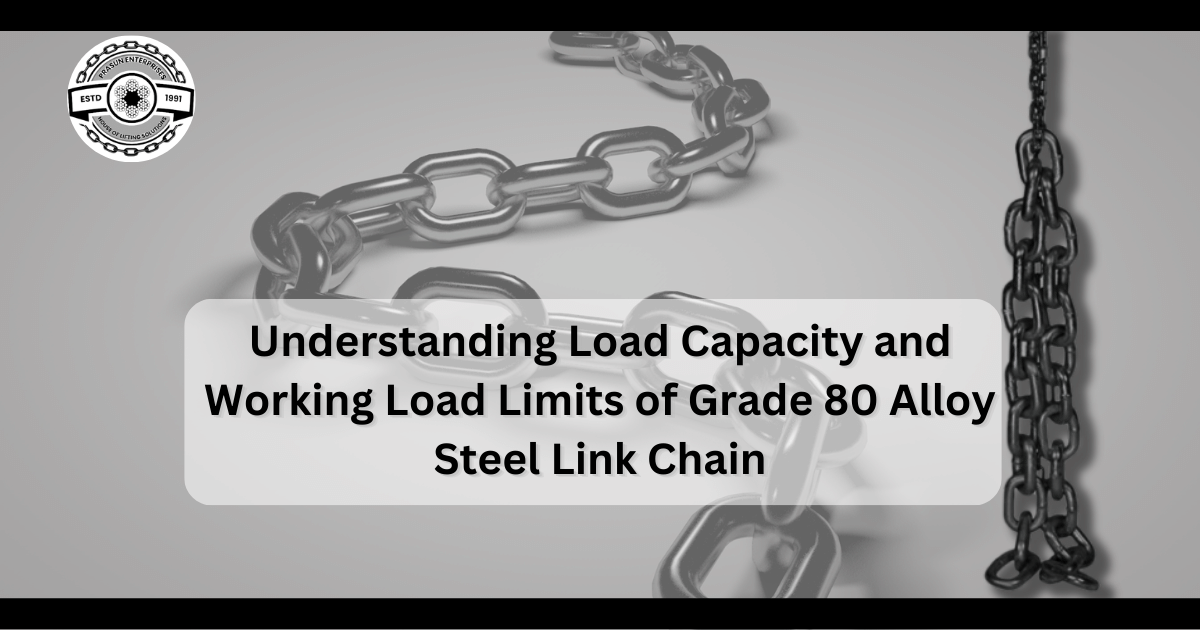
In the world of heavy-duty lifting, rigging, and securement, few things are as basic as understanding the load capacity and working load limits of equipment. Grade 80 alloy steel link chains, following IS: 6215 and IS: 6216 standards, are famous for their strong quality and flexibility. But what do these standards tell us about their load-bearing capabilities? In this blog post, we are going to explore the essential concepts of load capacity and working load limits in the context of Grade 80 alloy steel link chains, shedding light on how they handle immense burdens safely and efficiently.
Stack Capacity vs. Working Stack Restrain: Defining the Terms
Before diving into the specifics of Grade 80 alloy steel link chains, it’s essential to understand the distinction between load capacity and working load limit (WLL):
Load Capacity: The load capacity of a chain refers to its extreme breaking quality. It’s the supreme greatest load that the chain can withstand without breaking. This measure is ordinarily expressed in pounds or tons. The load capacity provides a clear indication of the chain’s crude strength, but it doesn’t take into consideration safety factors, operational conditions, or weakness.
Working Load Limit (WLL): The working load limit could be a more practical measure. It represents the greatest load that a chain can safely bear during routine use, under specified working conditions. WLL is always lower than the load capacity, and its factors in safety margins, natural conditions, and the expected fatigue of the chain. WLL is typically expressed in pounds or tons and is the figure to which operators must follow to guarantee safety.
Understanding the Working Load Limits of Grade 80 Chains
Grade 80 alloy steel link chains have notable WLLs due to their strong construction and design. These chains are well-suited for a variety of applications, thanks to their capacity to bear significant loads securely and efficiently. The WLL of Grade 80 chains is a result of fastidious engineering and conforming to IS: 6215 and IS: 6216 standards.
- Amazing WLL-to-Size Ratio: One of the surprising highlights of Grade 80 chains is their amazing WLL-to-size ratio. These chains offer high working load limits relative to their diameter and weight. This ratio is beneficial in applications where space and weight are basic components, such as in the transportation industry.
- Reliability in Heavy Lifting: Grade 80 chains are designed to exceed expectations in applications that include heavy lifting. Their considerable working load limits permit them to securely hoist and secure loads in construction, shipping, and material taking care of. From securing cargo on a flatbed trailer to lifting heavy machinery on a construction site, Grade 80 chains are the dependable choice for requesting tasks.
- Flexibility in Rigging: The flexibility of Grade 80 chains expands to their use in rigging. Their WLL makes them appropriate for use in a wide range of rigging arrangements, such as bridle, basket, or choker hitches. This versatility is important in industries like forestry, where rigging requests can change quickly.
- Security Assurance: The WLL of Grade 80 chains is calculated with safety in mind. It takes into consideration factors such as dynamic loading, fatigue, and environmental conditions. This approach guarantees that operators can depend on the chains to perform securely, decreasing the risk of accidents and failures.
- Compliance with Standards: Grade 80 alloy steel link chains conform to IS: 6215 and IS: 6216 standards, which indicate the criteria for deciding the WLL. Choosing Grade 80 chains means adjusting with recognized security rules, giving peace of mind to operators and guaranteeing compliance with industry directions.
- Building Greatness: The engineering behind Grade 80 chains contributes to their high working load limits. These chains are fastidiously designed and manufactured to optimize their load-bearing capabilities, making them a favored choice in industries where performance and safety are vital.
- Ductile Quality and WLL: The ductile quality of Grade 80 chains plays a crucial part in deciding their WLL. These chains boast amazing ductile quality, which permits them to handle higher loads securely.
- Thorough Testing: Manufacturers subject Grade 80 chains to thorough testing to decide their working load limits. This testing is conducted under controlled conditions to guarantee that the chains can reliably perform at their specified WLL.
Conclusion: Taking care of the Load Capacity and Working Load Limits
Understanding load capacity and working load limits is basic for safely and efficiently utilizing Grade 80 alloy steel link chains. The amazing WLL of Grade 80 chains is a confirmation to their designing excellence and their suitability for a wide range of applications. Whether it’s the transportation of heavy cargo, the rigging of loads in forestry, or securing equipment on construction sites, Grade 80 chains bear the burden with confidence, giving dependable performance and peace of mind to operators. These chains represent a foundation of security and efficiency in industries that depend on their quality and load-bearing capabilities.

